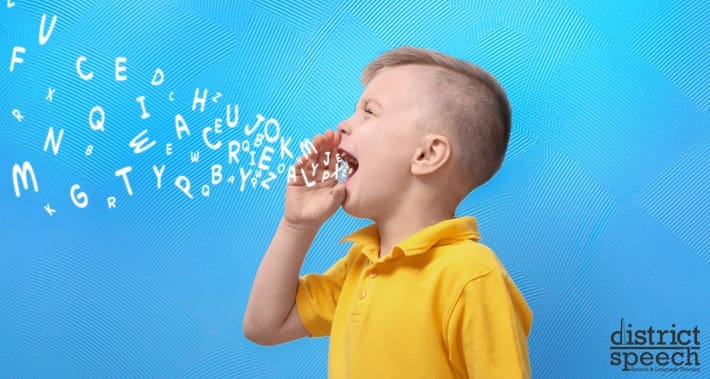
Have you ever been sitting at your speech therapist’s office, confused at the terminology they’re using, but feeling too embarrassed to ask for clarification?
Well, you’ve come to the right place.
We’re District Speech, a Washington DC speech therapist with a passion for patient education.
We know how intimidating starting speech therapy can be, especially if you’re struggling to understand the terminology being used by your speech therapist.
That’s why we’ve put together this series of articles to define commonly used speech therapy terms.
Previously, we covered:
- A Glossary Of Speech Therapy Terms: A to E
- A Glossary Of Speech Therapy Terms: F to M
- A Glossary Of Speech Therapy Terms: N to O
- A Glossary Of Speech Therapy Terms: P to R
Today, we’re finishing the series with S to Z.
Keep reading to find out more.
Semantics
Rather than language as a whole, the study of semantics looks at the meaning behind language.
It explores the relationship between your language, thoughts, and behavior.
For example, the same word can convey different meanings depending on the way you say it.
Think of the terms “goodbye” and “see you later”.
Both technically mean the same thing; however, they can convey different meanings depending on the context.
For instance, “see you later” implies an expected reunion at some point in the future whereas “goodbye” may signify a more permanent separation, depending on the context.
Semantics can apply to both single words as well as full sentences.
Speech Disorder
Speech disorders are clinical diagnoses given to individuals with atypical speech and language skills.
To be diagnosed with a speech disorder, your voice must be significantly impacted in one of the following ways:
- Vocal weakness (low volume, not easily heard)
- Not easily understood
- Vocally or visually unpleasant
- Sound production deviations
- Lack of conventional rhythm or stress
Speech disorders may be caused by both physical and psychological factors.
Common speech disorders include:
- Stuttering
- Cluttering
- Aphasia
- Social communication disorder
- Hypernasality
- Velopharyngeal insufficiency
- Orofacial myofunctional disorder (tongue thrust)
- Selective mutism
- Dysarthria
- Childhood apraxia of speech
- Ankyloglossia (tongue tie)
- Lisps
- And many more
Speech Mechanism
Your speech mechanisms are the various parts of your body involved in speech production.
Examples of speech mechanisms include:
- Your articulators, such as lips, tongue, and lower jaw (mandible)
- Your larynx
- Your resonators, such as oral and nasal cavities
- Your respiratory system
Speech disorders may affect one or multiple speech mechanisms.
Stuttering
Stuttering is a type of speech disorder which interferes with your voice’s fluency and time patterning.
For instance, people who stutter often repeat the first syllable of certain words or have difficulty starting speech.
Stuttering involves both primary characteristics, such as sound and syllable repetition, as well as secondary characteristics, such as eye blinking.
We’re currently not sure what causes stuttering in adults or kids.
RELATED: Famous People Who’ve Stuttered
Syntax
Syntax refers to the ways words are strung together in a sentence to convey meaning.
You can think of it as a set of rules that surround your everyday language.
For instance, if a sentence has a verb, subject, and direct object, syntax tells us that proper sentence structure would be subject, verb, direct object.
Tongue Thrust
Tongue thrusting is the tendency to place your tongue in the wrong position, typically pressing forward towards the teeth.
Tongue thrust is a common childhood condition that, left untreated, could result in dental issues, such as an open bite.
It can be caused by multiple factors, such as a feeding and swallowing disorder, allergies, and tongue tie.

Utterance
Utterance is a broad term used to describe any unit of speech characterized by breaths and pauses.
“Utter” means simply “to say”.
Therefore, mostly everything you say may be considered an utterance.
It includes simple phrases, such as “ew!” to bigger words as well as full sentences.
Even large units of language, such as a graduation speech, are considered utterances.
Velum
Velum is another word to describe your soft palate.
It includes your uvula as well as the arches in your mouth known as the palatoglossal and palatopharyngeal arches.
Your velum is responsible for closing your nasopharynx, a cavity in the upper part of your pharynx, during swallowing and speaking.
Certain medical conditions, such as cleft lip and cleft palate, can interfere with your velum’s functioning.
Book Your Appointment With District Speech Today
And now we’ve come to an end to our speech therapy terminology journal.
We hope these series of articles have helped you gained a better understanding of the terms being used in your speech therapy sessions.
If you’re looking to hear more about speech therapy, or have questions regarding speech therapy terminology, we’re just a phone call away.
Book your appointment with District Speech today to get started on your vocal transformation.
1300 I St NW, Suite 400 E,
Washington, DC 20005
- https://g.page/districtspeech
District Speech and Language Therapy specializes in speech therapy, physical therapy, and occupational therapy solutions, for both children and adults, in the Washington D.C and the Arlington Virginia areas.